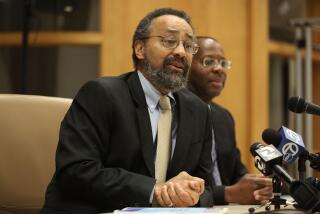John C. Harsanyi; Won Nobel for Game Theory
- Share via
John C. Harsanyi, the UC Berkeley economics professor who won a 1994 Nobel Prize for his work in game theory, died of a heart attack at his Berkeley home Wednesday.
He was 80 and had been suffering from Alzheimer’s disease.
Harsanyi shared the $930,000 prize with two other scholars of game theory, John F. Nash of Princeton University and Reinhard Selten of the University of Bonn.
Game theory occupies a specialized field of mathematics in which complex logic is applied to real-world scenarios of conflict and competition. By assigning numerical values to various strategies, game theory makes it possible to calculate winners and losers.
“Eventually, it will give us a higher standard of living because we make better decisions” in business and in government, Harsanyi told The Times when the prize was announced.
Derived from studies of games such as poker or chess, game theory has roots in the Cold War era. It was launched in a 1944 book, “The Theory of Games and Economic Behavior,” by two Princeton economists, John von Neumann and Oskar Morgenstern.
Harsanyi’s co-winner, Nash, made his greatest contribution by laying out the mathematical principles of games or rivalries in which all players have the same information.
In the 1960s, Harsanyi was an advisor to the federal government on disarmament talks with the Soviet Union. He found, however, that game theory was an imperfect tool because neither side knew much about the other. They were playing what theorists called a game of incomplete information. This was the chief weakness of Nash’s work: the assumption that players have perfect knowledge of their competitors’ motives and resources.
In a series of papers published in the mid- to late 1960s, Harsanyi did his most important work, developing mathematical models that showed rivals how to compete effectively without knowing their competitors’ next steps. It was this contribution that the Nobel committee cited in awarding Harsanyi the prize along with Nash and Selten.
“That was a revolutionary development,” UC Berkeley economist Thomas Marschak told the UC Berkeley publication California Monthly in 1994, “because it really allowed more realistic modeling in all economic situations.”
Harsanyi’s work broadened the theory’s use because, as he explained, “in real life, people very seldom have full knowledge” about their rivals.
Increasingly, game theory has attracted business strategists tackling complicated issues involving pricing, hostile takeovers, bidding for contracts and other strategies. Game theorists, for example, played a key role in designing the rules of a 1994 auction by the Federal Communications Commission of billions of dollars worth of radio wave licenses for new communications services. Bidders, including such industry giants as MCI and Nextel, hired game theorists to help them determine how much to bid for portions of the spectrum.
Airlines have used game theory to calculate their rivals’ plans and decide on profitable courses of action. It is valued for its ability to suggest solutions not apparent in conventional business analysis.
The theory’s utility is murkier in political situations, where the analysis often must be so simplified that it offers little insight. Harsanyi acknowledged its limitations in solving human conflicts. What it can do, he said, is “suggest what the different possible strategies are that have any hope of being good,” he told The Times in 1995.
Described by colleagues as a gentle and shy man, Harsanyi was born in Budapest, Hungary, the son of a Jewish pharmacist who had converted to Catholicism. Although his chief interests were mathematics and philosophy, he studied pharmacology at the University of Budapest and went to work at his father’s pharmacy because of the impending Nazi threat.
In 1944, during the German occupation of Hungary, Harsanyi was conscripted into a forced-labor unit. When his unit was taken to a railway station to await passage to Austria, he quietly removed the yellow armband identifying him as a Jew and slipped out of the terminal. He survived the rest of the war hidden by priests in a Jesuit monastery in Budapest.
When the war was over, he returned to the University of Budapest for a doctorate in philosophy. He taught sociology there, eventually resigning to work in his father’s pharmacy in the late 1940s when he found his liberal political views weren’t harmonious with the new Communist government.
In 1950, he fled with his fiancee to Austria and Australia, where they awaited entrance to the United States. While in Sydney, he worked in factories during the day and studied for a master’s degree in economics at night at the University of Sydney. After emigrating to the United States, he enrolled in a doctorate program in economics at Stanford University, where he wrote his dissertation on game theory under another future Nobel laureate, Kenneth Arrow.
He joined the UC Berkeley faculty in 1964, after teaching at Australian National University in Canberra and Wayne State University in Detroit. He was elected to the American Academy of Arts and Sciences in 1984 and the National Academy of Sciences in 1992.
He is survived by his wife, Anne, of Berkeley, and a son, Tom, of Somerville, Mass.
A memorial service is scheduled on Aug. 31 in the Great Hall of UC Berkeley’s faculty club.
Donations may be sent to the Alzheimer’s Assn. of the Greater Bay Area, 2065 W. El Camino Real, Mountain View, CA 94042.







